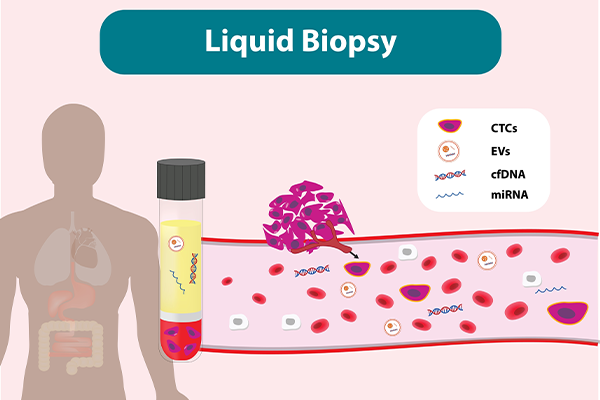
In the ever-evolving landscape of cancer diagnostics, liquid biopsy has emerged as a game-changing tool, offering a safer, faster, and less invasive alternative to traditional tissue biopsies. This innovative technique is redefining how clinicians detect, monitor, and personalise treatment for various types of cancer, all from a simple blood sample.
Synopsis
What is a Liquid Biopsy?
A liquid biopsy is a non-invasive diagnostic test that analyses tumour-derived components in body fluids, most commonly blood, but also urine, saliva, or cerebrospinal fluid, to detect cancer cells or cancer DNA (ctDNA). Unlike traditional biopsies that require surgical removal of tissue from the tumour site, liquid biopsies offer a quick and painless method to gather crucial information about a patient's cancer.

What Does a Liquid Biopsy Test For?
Liquid biopsy primarily analyses:
-
Circulating tumour DNA (ctDNA): Fragments of DNA shed by cancer cells into the bloodstream.
-
Circulating tumour cells (CTCs): Cancer cells that have detached from the primary tumour and entered the bloodstream.
-
Exosomes & microRNAs: Tiny vesicles and RNA molecules carrying cancer information.
These biomarkers help in identifying mutations, chromosomal changes, and gene expression patterns related to the cancer.
How is a Liquid Biopsy Performed?
-
A standard blood sample is drawn from the patient (usually 10–20 ml).
-
The blood is processed in a lab to isolate plasma.
-
Advanced molecular techniques such as Next-Generation Sequencing (NGS) or digital PCR are used to detect and analyse genetic material from tumour cells.
-
The results help identify mutations, drug targets, or signs of resistance to therapies.
Key Advantages of Liquid Biopsy
1. Non-Invasive and Safer
No surgery or anaesthesia is required, reducing risks and discomfort.
2. Real-Time Monitoring
Can be performed multiple times to monitor treatment response, tumour progression, or relapse.
3. Early Detection
It may be useful in future to detect cancer at early stages, especially in high-risk individuals.
4. Personalised Treatment
Helps identify genetic mutations that allow doctors to tailor targeted therapies.
5. Useful for Difficult-to-Biopsy Tumours
Ideal for cancers that are difficult to reach surgically, such as lung, brain, or pancreatic cancers.
Clinical Applications of Liquid Biopsy
1. Cancer Detection
-
It may be useful to detect early signs of cancers such as lung, breast, colon, prostate, and ovarian cancer.
2. Treatment Selection
-
Identifies actionable genetic mutations like EGFR, ALK, KRAS, or HER2 to guide targeted therapies.
3. Monitoring Response to Therapy
-
Helps assess how well a patient is responding to chemotherapy, immunotherapy, or targeted therapy.
4. Detecting Recurrence or Resistance
-
Tracks minimal residual disease (MRD) and detects mutations that indicate drug resistance or relapse.
Where is Liquid Biopsy Used in India?
Liquid biopsy is becoming increasingly available in India, especially in:
-
Tertiary care hospitals
-
Cancer research institutes
-
Private pathology labs with molecular diagnostic facilities
It is commonly used for lung cancer (NSCLC), colorectal cancer, and breast cancer, among others. Costs may vary depending on the panel size and technology used.
Limitations to Consider
While promising, liquid biopsy has some limitations:
-
Lower sensitivity than tissue biopsy in early-stage cancer
-
May miss mutations not present in the blood
-
Cannot provide detailed histological information
-
Still considered complementary, not a replacement for tissue biopsy in all cases
The Future of Liquid Biopsy
Research is ongoing to improve its accuracy, affordability, and applications in early cancer screening. In the future, liquid biopsies may become a part of routine cancer care, helping detect tumours before symptoms even arise and enabling truly personalised oncology.
Conclusion
Liquid biopsy is more than just a buzzword — it's a transformative advancement in cancer diagnostics that offers hope for earlier detection, better monitoring, and personalised treatment. As technology advances and becomes more widely accessible, it holds the potential to significantly improve outcomes for millions of cancer patients around the world, including in India. Contact us now to get the finest treatment from the best oncologist at Manipal Hospitals, Gurugram.
FAQ's
Unlike traditional biopsies, which involve removing tissue from the tumour through surgery or a needle, a liquid biopsy only requires a blood sample, making it safer, quicker, and easier for the patient.
Liquid biopsy is commonly used for lung, breast, colorectal, prostate, and ovarian cancers, and research is expanding its use to other cancer types as well.
In some cases, yes. Liquid biopsies can detect early genetic changes or mutations linked to cancer, although sensitivity in early-stage detection is still being improved. It may be useful in monitoring high-risk individuals.
Liquid biopsies are highly specific and increasingly accurate, especially for identifying known cancer mutations. However, they may not detect all types of tumours or provide complete information like a tissue biopsy might.
Not entirely. While it can complement or sometimes reduce the need for tissue biopsies, liquid biopsy does not provide histological (tissue structure) information, so both may be needed depending on the clinical situation.





















 4 Min Read
4 Min Read




.png)











